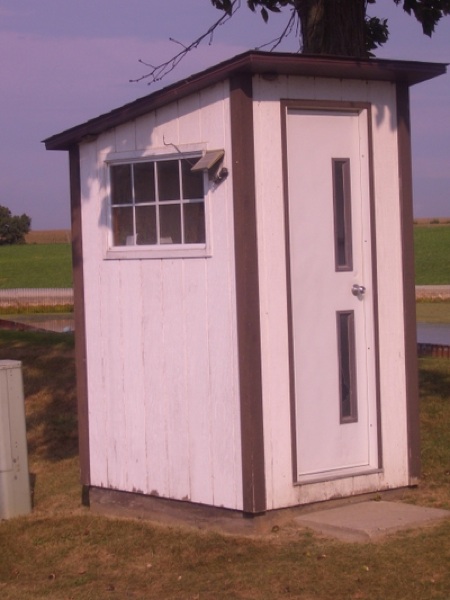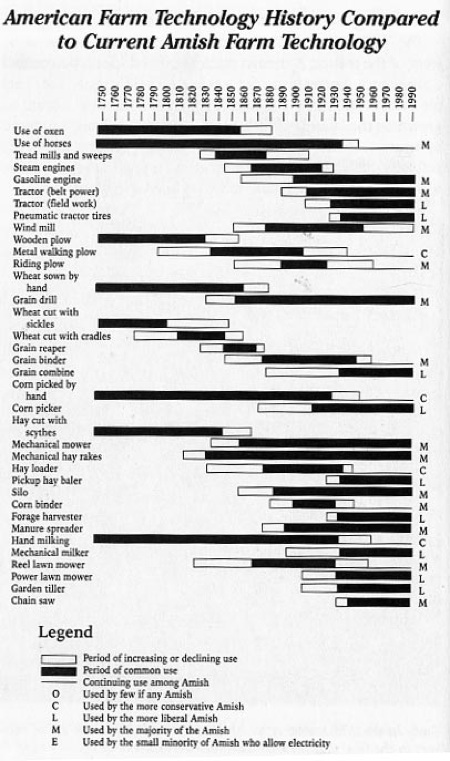Amish Hackers
[Translations: Japanese]
The Amish have the undeserved reputation of being luddites, of people who refuse to employ new technology. It’s well known the strictest of them don’t use electricity, or automobiles, but rather farm with manual tools and ride in a horse and buggy. In any debate about the merits of embracing new technology, the Amish stand out as offering an honorable alternative of refusal. Yet Amish lives are anything but anti-technological. In fact on my several visits with them, I have found them to be ingenious hackers and tinkers, the ultimate makers and do-it-yourselfers and surprisingly pro technology.

Homebuilt gas powered ice cutter to make ice for non-electric icebox.
First, the Amish are not a monolithic group. Their practices vary parish by parish. What one group does in Ohio, another church in New York may not do, or a parish in Iowa may do more-so. Secondly, their relationship to technology is uneven. On close inspection, most Amish use a mixture of old and very new stuff. Thirdly, Amish practices are ultimately driven by religious belief: the technological, environmental, social, and cultural consequences are secondary. They often don’t have logical reasons for their policies. Lastly, Amish practices change over time, and are, at this moment, adapting to the world at their own rate. In many ways the view of the Amish as old-fashioned luddites is an urban myth.
Like all legends, the Amish myth is based on some facts. The Amish, particular the Old Order Amish — the stereotypical Amish depicted on calendars – really are slow to adopt new things. In contemporary society our default is set to say “yes” to new things, and in Old Order Amish societies the default is set to “no.” When new things come around, the Amish automatically start by refusing them. Thus many Old Order Amish have never said yes to automobiles, a policy established when automobiles were new. Instead, they travel around in a buggy hauled by a horse. Some orders require the buggy to be an open carriage (so riders – teenagers, say – are not tempted with a private place to fool around); others will permit closed carriages. Some orders allow tractors on the farm, if the tractors have steel wheels; that way a tractor can’t be “cheated” to drive on the road like a car. Some groups allow farmers to power their combine or threshers with diesel engines, if the engine only drives the threshers but is not self-propelled, so the whole smoking, noisy contraption is pulled by horses. Some sects allow cars, if they are painted entirely black (no chrome) to ease the temptation to upgrade to the latest model.

Horse-drawn diesel baler, from Old Order Amish
Behind all of these variations is the Amish motivation to strengthen their communities. When cars first appeared at the turn of last century the Amish noticed that drivers would leave the community to go shopping or sight-seeing in other towns, instead of shopping local and visiting friends, family or the sick on Sundays. Therefore the ban on unbridled mobility was aimed to make it hard to travel far, and to keep energy focused in the local community. Some parishes did this with more strictness than others.
A similar communal motivation lies behind the Old Order Amish practice of living without electricity. The Amish noticed that when their homes were electrified with wires from a generator in town, they became more tied to the rhythms, policies and concerns of the town. Amish religious belief is founded on the principle that they should remain “in the world, not of it” and so they should remain separate in as many ways possible. Being tied to electricity tied them into the world, so they surrendered its benefits in order to stay outside the world. For many Amish households even today, you’ll see no power lines weaving toward their homes. They live off the grid.
To live without electricity or cars eliminates most of what we expect from modernity. No electricity means no internet, TV, or phones as well, so suddenly the Amish life stands in stark contrast to our complex modern lives.
But when you visit an Amish farm, that simplicity vanishes. The simplicity vanishes even before you get to the farm. Cruising down the road you may see an Amish kid in a straw hat and suspenders zipping by on roller blades. In front of one school house I spied a flock of parked scooters, which is how the kids arrived there. Not Razors, but hefty Amish varieties. But on the same street a constant stream of grimy mini-vans paraded past the school. Each was packed with full-bearded Amish men sitting in the back. What was that about?
Turns out the Amish make a distinction between using something and owning it. The Old Order won’t own a pickup truck, but they will ride in one. They won’t get a license, purchase an automobile, pay insurance, and become dependent on the automobile and the industrial-car complex, but they will call a taxi. Since there are more Amish men than farms, many men work at small factories and these guys will hire vans driven by outsiders to take them to and from work. So even the horse and buggy folk will use cars – under their own terms. (Very thrifty, too.)
The Amish also make a distinction between technology they have at work and technology they have at home. I remember an early visit to an Amish man who ran a woodworking shop near Lancaster, Pennsylvania. Most of the interior of the dark building was lit naturally from windows, but hanging over the wooden meeting table in a very cluttered room was a single electrical light bulb. The host saw me staring at it, and when I looked at him, he just shrugged and said that it was for the benefit of visitors like myself.
However while the rest of his large workshop lacked electricity beyond that naked bulb, it did not lack power machines. The place was vibrating with an ear-cracking racket of power sanders, power saws, power planers, power drills and so on. Everywhere I turned there were bearded men covered in saw dust pushing wood through screaming machines. This was not a circle of Renaissance craftsman hand tooling masterpieces. This was a small-time factory cranking out wooden furniture with machine power. But where was the power coming from? Not from windmills.
The boss, Amos (not his real name: the Amish prefer not to call attention to themselves), takes me around to the back where a huge dump-truck-sized diesel generator sits. It’s massive. In addition to a gas engine there is a very large tank, which I learn, stores compressed air. The diesel engine burns fuel to drive the compressor that fills the reservoir with pressure. From the tank a series of high-pressure pipes snake off toward every corner of the factory. A hard rubber flexible hose connects each tool to a pipe. The entire shop runs on compressed air. Every piece of machine is running on pneumatic power. Amos even shows me a pneumatic switch, which you can flick like a light switch, to turn on some paint-drying fans.
The Amish call this pneumatic system “Amish electricity.” At first pneumatics were devised for Amish workshops, but it was seen as so useful that air-power migrated to Amish households. In fact there is an entire cottage industry in retrofitting tools and appliances to Amish electricity. The retrofitters buy a heavy-duty blender, say, and yank out the electrical motor. They then substitute an air-powered motor of appropriate size, add pneumatic connectors, and bingo, your Amish mom now has a blender in her electrical-less kitchen. You can get a pneumatic sewing machine, and a pneumatic washer/dryer (with propane heat). In a display of pure steam-punk nerdiness, Amish hackers try to outdo each other in building pneumatic versions of electrified contraptions. Their mechanical skill is quite impressive, particularly since none went beyond the 8th grade. They love to show off this air-punk geekiness. And every tinkerer I met claimed that pneumatics were superior to electrical devices because air was more powerful and durable, outlasting motors which burned out after a few years hard labor. I don’t know if this is true, or just justification, but it was a constant refrain.
I visited one retrofit workshop run by a strict Mennonite. Marlin was a short beardless man (no beards for the Mennonites). He uses a horse and buggy, has no phone, but electricity runs in the shop behind his home. They use electricity to make pneumatic parts. Like most of his community, his kids work along side him. A few of his boys use a propane powered fork lift with metal wheels (no rubber so you can’t drive it on the road) to cart around stacks of heavy metal as they manufacture very precise milled metal parts for pneumatic motors and for kerosene cooking stoves, an Amish favorite. The tolerances needed are a thousand of an inch. So a few years ago they installed a massive, $400,000 computer-controlled milling (CNC) machine in his backyard, behind the horse stable. This massive half-million dollar tool is about the dimensions of a delivery truck. It is operated by his 14-year old daughter, in a bonnet. With this computer controlled machine she makes parts for grid-free horse and buggy living.
One can’t say “electricity-free” because I kept finding electricity in Amish homes. Once you have a huge diesel generator running behind your barn to power the refrigeration units that store the milk (the main cash crop for the Amish), it’s a small thing to stick on a small electrical generator. For re-charging batteries, say. You can find battery-powered calculators, flashlights, electric fences, and generator-powered electric welders on Amish farms. The Amish also use batteries to run a radio or phone (outside in the barn or shop), or to power the required headlights and turn signals on their horse buggies. One clever Amish fellow spent a half hour telling me the ingenious way he hacked up a mechanism to make a buggy turn signal automatically turn off when the turn was finished, just as it does in your car.
Nowadays solar panels are becoming popular among the Amish. With these they can get electricity without being tied to the grid, which was their main worry. Solar is used primarily for utilitarian chores like pumping water, but it will slowly leak into the household. As do most innovations.
The Amish use disposable diapers (why not?), chemical fertilizers, pesticides, and are big boosters of genetically modified corn. In Europe this stuff is called Frankenfood. I asked a few of the Amish elders about that last one. Why plant GMOs? Well, they reply, corn is susceptible to the corn borer which nibbles away at the bottom of the stem, and occasionally topples over the stalk. Modern 500 horsepower harvesters don’t notice this fall; they just suck up all the material, and spit out the corn into a bin. The Amish harvest their corn semi-manually. It’s cut by a chopper device and then pitched into a thresher. But if there are a lot of stalks that are broken, they have to be pitched by hand. That is a lot of very hard sweaty work. So they plant Bt corn. This genetic mutant carries the genes of the corn borer’s enemy, Bacillus thuringiensis, which produces a toxin deadly to the corn borer. Fewer stalks are broken, the harvest can be semi-mechanized, and yields are up as well. One elder Amishman whose sons run his farm told me that he’d only help his sons harvest if they planted Bt corn. He said he told them he was too old to be pitching heavy broken corn stalks. The alternative was to purchase expensive, modern harvesting equipment. Which none of them want. So the technology of genetically modified crops allowed the Amish to continue using old, well-proven, debt-free equipment, which accomplished their main goal of keeping the family farm together. They did not use these words, but they considered genetically modified crops as appropriate technology for family farms.
Artificial insemination, solar power, and the web are technologies that Amish are still debating. They use the web at libraries (using but not owning). From cubicles in public libraries Amish sometimes set up a website for their business. So while Amish websites seem like a joke, there’s quite a few of them. What about post-modern innovations like credit cards? A few Amish got them, presumably for their businesses at first. But over time the bishops noticed problems of overspending, and the resultant crippling interest rates. Farmers got into debt, which impacted not only them but the community since their families had to help them recover (that’s what community and families are for). So, after a trial period, the elders ruled against credit cards.
One Amish-man told me that the problem with phones, pagers, and PDAs (yes he knew about them) was that “you got messages rather than conversations.” That’s about as an accurate summation of our times as any. Henry, his long white beard contrasting with his young bright eyes told me, “If I had a TV, I’d watch it.” What could be simpler?

Amish solar-powered phone shanty in Holmes County, OH.
But no looming decision is riveting the Amish themselves as much as the question of whether they should accept cell phones. Previously, Amish would build a shanty at the end of their driveway that housed an answering machine and phone, to be shared by neighbors. The shanty sheltered the caller in rain and cold, and kept the grid away from the house, but the long walk outside reduced use to essential calls rather than gossip and chatting. Cell phones were a new twist. You got a phone without wires. You could take business calls without being wired to the world. As one Amish guy told me, “What is the difference if I stand in my phone booth with a wireless phone or stand outside with a cell phone. There’s no difference.” Further cell phones were embraced by women who could keep in touch with their far-flung family since they didn’t drive. But the bishops also noticed that the cell phone was so small it could be kept hidden, which was a concern for a people dedicated to discouraging individualism. Ten years ago when I was editing Wired I sent Howard Rheingold to investigate the Amish take on cell phones. His report published in January 1999 makes it clear that the Amish had not decided on cell phones yet. Ten years later they are still deciding, still trying it out. This is how the Amish determine whether technology works for them. Rather than employ the precautionary principle, which says, unless you can prove there is no harm, don’t use new technology, the Amish rely on the enthusiasm of Amish early adopters to try stuff out until they prove harm.
For being off the grid, without TV, internet, or books, the Amish are perplexingly well-informed. There’s not much I could tell them that they didn’t know about, and already had an opinion on. And surprisingly, there’s not much new that at least one person in their church has not tried to use. The typical adoption pattern went like this:
Ivan is an Amish alpha-geek. He is always the first to try a new gadget or technique. He gets in his head that the new flowbitzmodulator would be really useful. He comes up with a justification of how it fits into the Amish orientation. So he goes to his bishop with this proposal: “I like to try this out.” Bishop says to Ivan, “Okay Ivan, do whatever you want with this. But you have to be ready to give it up, if we decide it is not helping you or hurting others.” So Ivan acquires the tech and ramps it up, while his neighbors, family, and bishops watch intently. They weigh the benefits and drawbacks. What is it doing to the community? Cell phone use in the Amish began that way. According to anecdote, the first Amish alpha geeks to request permission to use cell phones were two ministers who were also contractors. The bishops were reluctant to give permission but suggested a compromise: keep the cell phones in the vans of the drivers. The van would be a mobile phone shanty. Then the community would watch the contractors. It seemed to work so others early adopters picked it up. But still at any time, even years later, the bishops can say no.
I visited a shop that built the Amish’s famous buggies. From the outside the carts look simple and old fashioned. But inspecting the process in the shop, they are quite high tech and surprisingly complicated rigs. Made of lightweight fiberglass, they are hand cast, and outfitted with stainless steel hardware and cool LED lights. The owner’s teenage son, David, worked at the shop. Like a lot of Amish who work along side their parents from an early age, he was incredibly poised and mature. I asked him what he thought the Amish would do about cell phones. He snuck his hand into his overalls and pulled one out. “They’ll probably accept them,” he said and smiled. He then quickly added that he worked for the local volunteer fire department, which was why he had one. (Sure!) But, his dad chimed in, if cell phones are accepted “there won’t be wires running down the street to our homes.”
In their goal to remain off the grid, yet modernize, some Amish have installed inverters on their diesel generators linked to batteries to provide them with off-grid 110 volts. They power specialty appliances at first, like an electric coffee pot. I saw one home with an electric copier in the home office part of their living room. Will the slow acceptance of modern appliances creep along until 100 years hence the Amish have we have now (but have left behind)? What about cars? Will the Old Order ever drive old-fashioned internal combustion clunkers, say when the rest of the world is using personal jet packs? Or will they embrace electric cars? I asked David, the 18-year old Amish, what he expects to use in the future. Much to my surprise he had a ready teenage answer. “If the bishops allow the church to leave behind buggies, I know exactly what I will get: a black Ford 460 V8.” That’s a 500 hp muscle car. But it is in black! His dad, the carriage maker, again chimed in, “Even if that happens there will always be some horse and carriage Amish.”
David then admitted, “When I was deciding whether to join the church or not, I thought of my future children and whether they would be brought up without restrictions. I could not imagine it.” A common phrase among the Amish is ‘holding the line.” They all recognize the line keeps moving, but a line must remain.
My impression is that the Amish are living about 50 years behind us. They don’t adopt everything new but what new technology they do embrace, they take up about half a century after everyone else does. By that time, the benefits and costs are clear, the technology stable, and it is cheap. Consider this chart I found in the book “Living Without Electricity”. You can see the hint of a delay pattern in Amish adoption.

The Amish are steadily adopting technology — at their pace. They are slow geeks. As one Amish man told Howard Rheingold, “We don’t want to stop progress, we just want to slow it down,” But their manner of slow adoption is instructive.
- 1) They are selective. They know how to say “no” and are not afraid to refuse new things. They ban more than they adopt.
- 2) They evaluate new things by experience instead of by theory. They let the early adopters get their jollies by pioneering new stuff under watchful eyes.
- 3) They have criteria by which to select choices: technologies must enhance family and community and distance themselves from the outside world.
- 4) The choices are not individual, but communal. The community shapes and enforces technological direction.
This method works for the Amish, but can it work for the rest of us? I don’t know. It has not really been tried yet. And if the Amish hackers and early adopters teach us anything, it’s that you have to try things first. Try first and relinquish later if need be. We are good at trying first; not good at relinquishing – except as individuals. To fulfill the Amish model we’d have to get better at relinquishing as a group. Social relinquishing. Not merely a large number (as in a movement) but a giving up that relies on mutual support. I have not seen any evidence of that happening, but it would be a telling sign if it did appear.



